Last week's "What the ... ?"
In the last issue, I asked y’all to identify the culprit that'd created the sand piles in the pictures below. I had no idea what it was, so I needed your help.
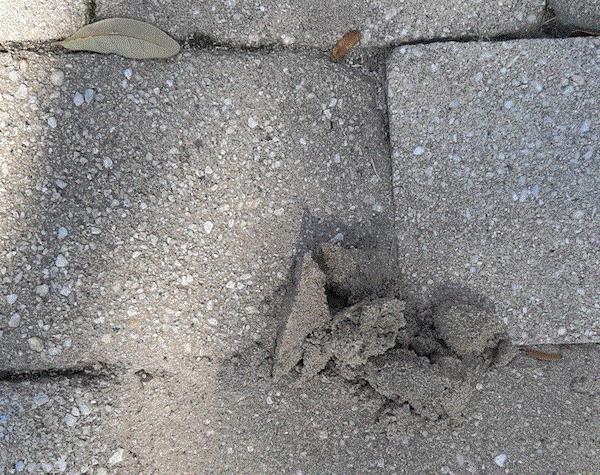
I received a few guesses, from wasps to sasquatch larvae, and anything in between. The majority thought the culprit was a mole. My guesses were terrestrial crawfish or a mole; more likely a mole now that I think more carefully about it. Again, I don't know if it was a mole or not since I didn't have a chance to examine the sand pile in person and dig underneath it. Just to show you that if you want a problem diagnosed correctly, you’ll have to get your hands dirty!
Many thanks to Cookie Ballard, Chris Boggs, Brandon Hockema, Jed Lafferty, Carolyn Thomas and Brian Walsh for humoring me. Thanks again, everyone!
This week's "What the ... ?"
John Lawton, who's a technician for Clemson University’s Peach Breeding and Genetics Program—and about to become a newly minted Master of Science in Plant and Environmental Sciences—sent me a few pictures of what he described as “clams” that can’t be plied open on his arborvitae. John was wondering if these are scale insects.
What do you think?
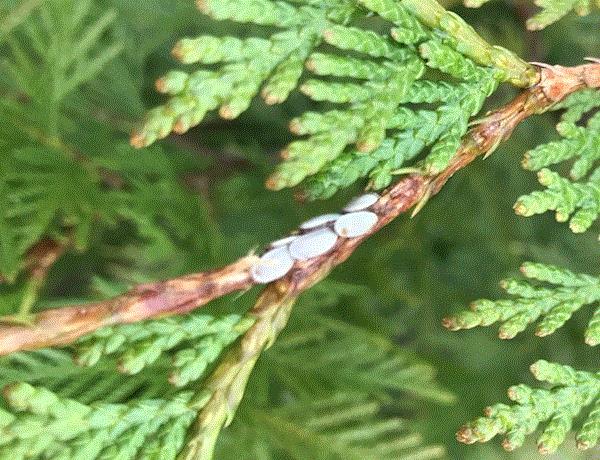
IR-4 publishes an updated Botrytis efficacy summary
The last version of IR-4’s Botrytis efficacy summary was published in April 2019. In this updated version, data from four trials conducted on hydrangea, geranium and poinsettia in 2019 and 2020 were included.
Here's a summary of the efficacy summary:
Fifty-two active ingredients were evaluated as foliar spray applications against four Botrytis species (most trials were conducted against Botrytis cinerea). Data collected from 1998 to 2020 suggested that Compass (fluazinam; FRAC 29), Daconil (chlorothalonil; M5), Decree (fenhexamid; 17), Heritage (azoxystrobin; 11), Insignia Intrinsic (pyraclostrobin; 11), Pageant Intrinsic (boscalid + pyraclostrobin; 7 + 11), and Palladium (cyprodinil + fludioxonil; 9 + 12) provided excellent efficacy. Whereas Chipco 26019 (iprodione; 2) and Veranda O (polyoxin D zinc salt; 19) provided good efficacy.
Among the new products, Orkestra Intrinsic (fluxapyroxad + pyracllostrobin; 7 + 11), Mural (azoxystrobin + benzovindiflupyr; 11 + 7), Emblem (fludioxonil; 12), Rhapsody and Serenade (Bacillus subtilis strain QST 713; BM02), and Astun (isofetamid; 7) seemed effective.
Disarm (fluoxastrobin; 11) was mediocre. Botector (Aureobasidium pullulans), Proud 3 (thyme oil; 46), ZeroTol (hydrogen peroxide + peroxyacetic acid) and copper products (Badge X2, Camelot and Phyton 27; M1) performed poorly.
More data are needed before conclusions could be made for Broadform (fluopyram + trifloxystrobin; 7 + 11), EcoSwing (extract of Swinglea glutinosa; BM01), Oxiphos (hydrogen peroxide + potassium salts of phosphorous acid), PreStop (Gliocladium catenulatum strain J1466; BM02), Prophytex (Bacillus subtilis; BM02), Regalia (extract of Reynoutria sachalinensis; P5), Regime (banda de Lupinus albus doce or “BOLD”; BM01), Torque (tebuconazole; 3), Tourney (metconazole; 3), and Trinity (triticonazole; 3).
Get a copy of IR-4's Botrytis efficacy summary by clicking here.

Answer to this week’s “What the … ?”
What John thought was scale insects were actually katydid eggs. I didn't really solve the mystery for John; only to tell him that those are likely eggs of some creatures and it’d take me a little time to find out what they actually are. John responded shortly afterward with a picture of katydid eggs he found online, which looked very similar. What detective work—kudos!
Y’all know katydids, right? They look like grasshoppers that love to hang out on trees and shrubs. I've seen them ranging from green to brown to pink. I've also seen them in different shapes and sizes—some have spines and some look just like a piece of dried leaf. Fascinating creatures.
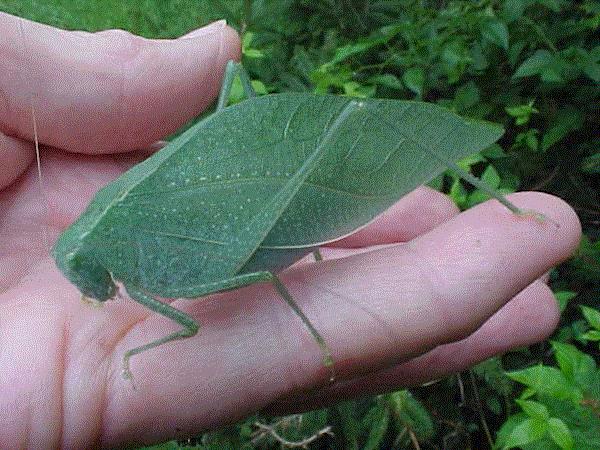
Photo credit: Jeannie Soter, bugwood.org.
They're perhaps my favorite songsters of summer nights. There's only one generation per year and all singing katydids (or non-singing females since only the males sing) die at the end of the year. The population overwinters as eggs glued to leaves or stems, or deposited in soil and debris. It’s difficult to identify the species based on eggs. The eggs John found were yet to hatch at the time the picture was taken because no exit holes were on the eggs.
Although katydids chew on leaves here and there, they don't cause any noticeable damage to plants. The next creature in this newsletter, however, can be more damaging ...

Brood X is coming!
What could be more interesting than trillions of buzzing cicadas? No, no, katydids and cicadas (or “locusts” by some) ain’t related! Cicadas are more closely related to a treehopper or a planthopper. Those katydid eggs on the arborvitae just reminded me of cicada’s oviposition wounds on woody trees.
Not just any typical good ol' dog-day cicada either! We’re talking about the periodical cicadas, AKA the red-eyed devils. (Okay, only I call them that.)
More specifically, Brood X periodical cicadas, which will be emerging after growing quietly underground for 17 years. In some areas, as many as 1.4 million individuals could emerge from a single acre. Compare to Brood X, other broods (such as Brood IX of 2020) are almost like jokes. As if to make up for lost time, these periodical cicadas will have a very loud and riotous party in the spring.
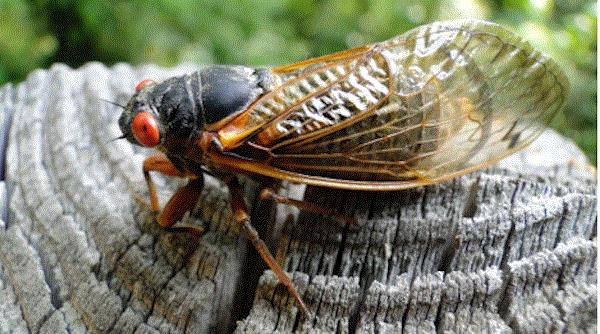
An adult periodical cicada. (Photo credit: Clyde Sorenson, North Carolina State University.)
Get ready for the onslaught my friends in Delaware, northern Georgia, eastern Illinois, Indiana, northern Kentucky, Maryland, southern Michigan, New Jersey, southern New York, western North Carolina, western Ohio, southern and eastern Pennsylvania, eastern Tennessee, northern Virginia, and eastern West Virginia! There’ll be a lot of finger pointing among neighbors about who's brought God’s wrath on this earth. I can see why some would call periodical cicada emergence a locust plague.
What about South Carolina, you ask? Well, thank you for noticing that. Yes, we South Carolinians are spared this year, but we look forward to our very own Great Southern Broad (AKA Brood XIX) in 2024! The kicker is Brood XIX is a 13-year brood, meaning that I’ll hear them after a shorter intermission than y’all with the 17-year broods.
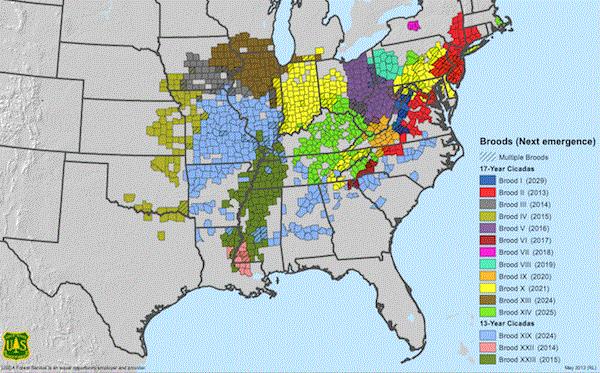
The distribution of periodical cicada broods in the United States. (Figure credit: USDA Forest Service.)
Okay, there are a lot of them, and they’re loud, but what’s the big deal? They're not as harmless as loud teenagers. More than just annoying, periodical cicadas can actually damage trees. They deposit eggs in stems of woody plants. A female cicada has a large and serrated ovipositor, which she uses to slice open bark on thin stems to deposit her eggs. Each stem can have multiple oviposition wounds. If there are a lot of ovipositing cicadas, which there will be, the stems may be damaged so severely that they’ll wither, flag and break off. Nursery stock and newly transplanted trees are at a greater risk of damage.
Mike Raupp of the University of Maryland published a wonderful article in TCI Magazine. Mike describes the biology, damage and management of the periodical cicadas from a tree-care standpoint. If you live in an area to be overrun by Brood X and plan to put in a woody plant or two this spring, don't. Wait until the cicadas are gone.
After examining research data, Mike concluded that enveloping the susceptible trees (the article has a list of these tree genera) with nets of 1-cm size mesh is perhaps the most effective preventive management approach, especially for newly transplanted trees. It makes no sense trying to spray your way out of the onslaught because, sure, you can kill a thousand of them, but there are a million waiting to take the places of the fallen. Check out Mike’s article for more insights on periodical cicadas.

"What the ... ?" for next time
Here's a great “What the …?” mystery for y’all to contemplate while looking out over the great horizon on a misty spring morning. (Or, if you're like me, the great tangle of a wood that should have been thinned five years ago, but is now tinted yellow by pollen.)
I visited a grower in North Carolina a few weeks ago, and took these pictures of black, felt-like mold on the trunks and branches of Wildfire Nyssa. On some branches, I also saw patches of hard, light brown mats. When I cut under the fungal growth, the plant tissues appeared alive and healthy.
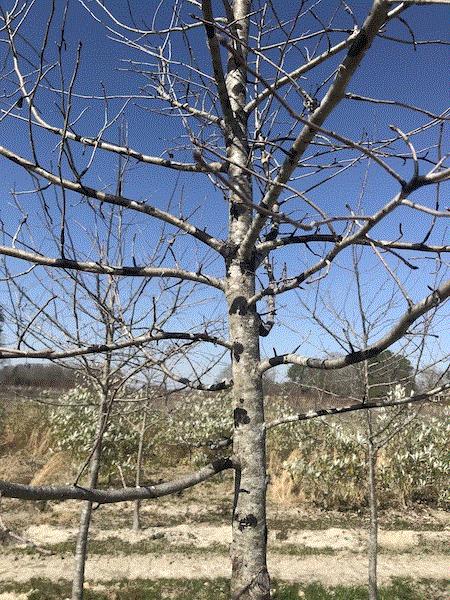
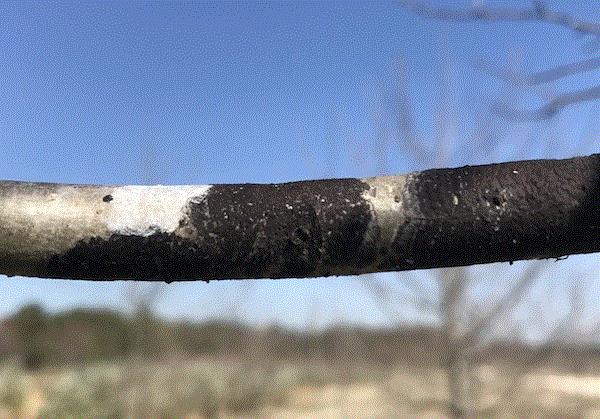
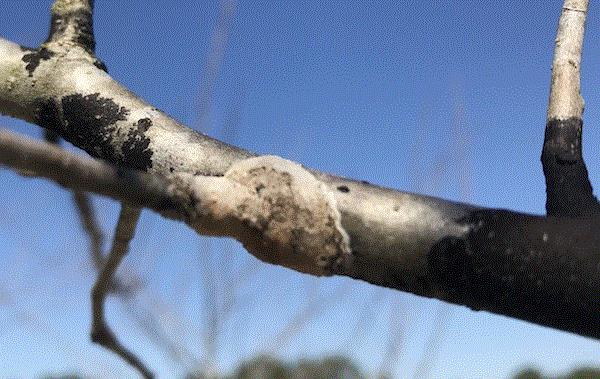
The grower has wondered about this fungal growth for the past five years, so he was very excited to show me. He also reported that the fungi are only present on scale insect-infested trees. I was thinking, “Fungus that grows with scale insects? Really? It’s almost like entomologists and plant pathologists actually getting along!” (Entomologists and pathologists yank each other’s chain all the time, but we get along!)
What is this black felt fungus?
If you know the answer, or just want to guess, email me by clicking here. I’ll make the big reveal in the next issue of this newsletter.



See y'all later!

JC Chong
Professor of Entomology at Clemson University
This e-mail received by 23,489 subscribers like you!
If you're interested in advertising on PestTalks contact Kim Brown ASAP!